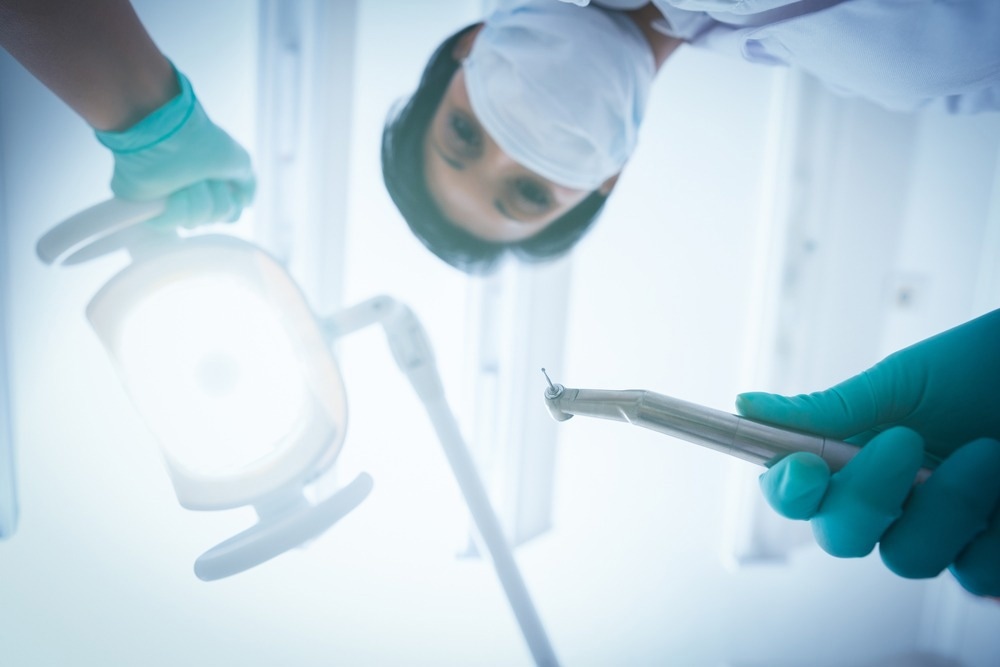Light-emitting diode (LED) headlamps are used frequently by dentists. The potential "blue light hazard" to the retina posed by these white light headlights is uncertain.

Study: The potential ‘Blue Light Hazard’ from LED Headlamps. Image Credit: wavebreakmedia/Shutterstock.com
Pre-proof research in the Journal of Dentistry explores the use of integrating spheres connected to fiber-optic spectroradiometers. The researchers evaluated the spectrum of radiant powers obtained from direct and indirect observation of an electronic tablet, a halogen headlamp, a LED curing light, and six different brands of LED headlamps.
The Blue Light Hazard
Blue light exposure can disturb sleep patterns and cause retinal damage, according to research on animals and in cell cultures (ARMD). The harmful effects of blue light develop over time.
Wavelengths of 440-450 nm cause maximum blue light hazards. Damage happens because the cornea, vitreous humor, aqueous humor, and lens do not absorb the blue wavelengths of light.
Blue light is reflected through the ocular medium and then directly absorbed by the pigments in the retina. The color temperature (K) of the light source seems to impact the harmful effects of blue light. Cool white temperatures over 4500K, observed from "bright white" light LEDs, are less dangerous than temperatures in the vicinity of 3000K, commonly seen from incandescent sources.
Response of the Retina to Blue Light
Human eyes are only 5% susceptible to blue light between 440 and 450 nm compared to light of 550 nm the peak of blue light from white light LED sources. High wavelength of light limits the functioning of the human eye.
Since the human pupil does not dilate and compress when exposed to blue light, the human eye may be affected by exposure to high amounts of blue light without knowledge. Even modest variations in pupil diameter significantly affect the quantity of light entering the eye. A 4 mm pupil (area: 12.57 mm2) allows four times additional light to enter the retina than a 2 mm pupil (area 3.14 mm2).
Because the eye is more sensitive to light in the 510 to 580 nm band, light from a halogen light source, the ratio of blue light to red-green wavelengths in the white light from LEDs is crucial. Red/green wavelengths should preferably predominate over blue wavelengths.
Blue Light Hazards of LED Headlamps
White light LED headlamps produce a variety of spectrums that all possess higher risks of causing retinal damage than halogen sources. The "blue light hazard" from some LED headlamps is larger than LED curing light when the headlamps are placed at a distance of 35 cm.
Hazards from Dentist LED Headlamps
Dentists spend around four hours per day examining digital displays that generate blue light. Dentists are unprotected from artificial blue light from LEDs lights, headlamps, and operatory lights.
Many dentists are ignorant of the possible "blue light hazards" at the dental clinic and do not employ proper eye protection, although the potential harm of the blue light from various dental curing lights has been extensively recorded. Dentists are not usually aware of the possible blue light hazards posed by LEDs that emit strong white light since the light is white.
Prince et al. showed and described the blue light hazard from white light headlamps to evaluate the daily cumulative exposure limit (tMAX). The blue light from these headlamps can be surpassed at the dental clinic in light of public concerns and the widespread usage of bright white LED headlights.
Research Findings
The headlight temperature, radiant strengths, and emission spectra are all significantly distinct and do not provide a comparable "blue light hazard. Between the most powerful LED headlamps and the halogen headlamp, the total powers radiate at zero distance ranges from 47 mW to 378 mW.
The temperatures of headlamps vary from 3098 K to 7253 K. When the headlamps are viewed directly at a distance of 35 cm, the exposure periods for an 8-hour day are 810 s for the halogen headlamp, 53 to 220 s for the LED headlamps, and 62 s for the LED curing light.
White light LED headlamps produce a variety of spectrums that all have a higher risk of causing retinal damage than halogen. The "blue light hazard" from some headlights was larger than from an LED curing light.
The SurgiTel Warm headlamp, one of the several LED-based headlamps evaluated by Prince et al. generates a high luminous output of 98 lm at 3098 K. At a distance of 35 cm, it provides the longest cumulative daily exposure time (tMAX) of 205 seconds.
As far as the solution is concerned, patients should put on safety goggles designed to filter out blue light. The cumulative daily exposure duration (tMAX) for healthy persons throughout an 8-hour day was not exceeded by indirect viewing of LED headlights at a distance of 35 cm. The risk is raised and the maximum cumulative daily exposure duration (tMAX) can be shortened.
Reference
Price, R. B., Labrie, D., Sullivan, B., & Sliney, D. H. (2022). The potential ‘Blue Light Hazard’ from LED Headlamps. Journal of Dentistry, 104226. https://www.sciencedirect.com/science/article/abs/pii/S0300571222002822
Disclaimer: The views expressed here are those of the author expressed in their private capacity and do not necessarily represent the views of AZoM.com Limited T/A AZoNetwork the owner and operator of this website. This disclaimer forms part of the Terms and conditions of use of this website.